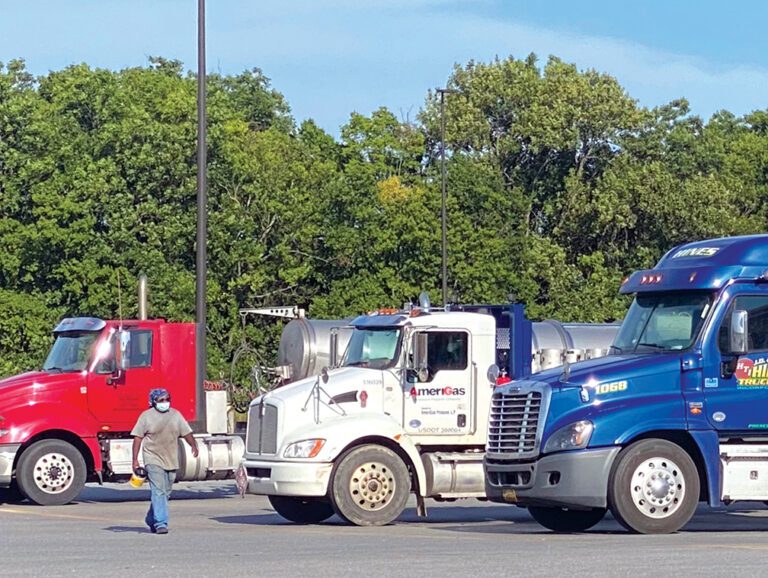Every professional driver knows that the highway can be a dangerous place. From other motorists to construction, weather and other conditions, the list of possible hazards is enough to stress out even the best driver. It can feel awfully good to get safely parked and get some needed rest.
Unfortunately, the stress doesn’t always end when the day’s driving is done. In fact, just finding a place to park can be one of the most stressful parts of a trucker’s day.
The issue is one with which Jim Smith, vice-president of Specialty Safety at ProDrivers (an Employbridge company) is familiar.
“A recent study by the American Transportation Research Institute (ATRI), says that 85% of drivers cited parking as the number-one cause of job-related stress,” Smith said. “Should the driver be stressed about their security — or even their ability to find parking — it could contribute to fatigue and ultimately, accidents.”
There is no solution that works for everyone in every locale.
In some areas of the country, there simply aren’t enough available spaces to accommodate all the truckers who need rest. Property values, local zoning laws and regulatory restrictions discourage the creation or expansion of truck stops and parking areas. Environmental laws that prohibit idling, or even running auxiliary power units, make it impossible to rest comfortably even if a parking space is found.
Despite these obstacles, there are some things drivers can do to improve the chances of finding a parking place. One of the most effective is planning for parking during the initial trip plan. This an area in which technology can actually be a hinderance, as some drivers receive routing along with each dispatch, mandating which roads they must travel and where fuel is to be purchased. Where the driver will park for rest is usually not considered in the planning.
Phone apps have taken the place of the old highway exit guide, although these printed guides do still exist. The iExit app is popular but isn’t specific to trucking. TruckerPath is widely used and allows users to enter comments to pass along information to others. A search for “truck parking apps” at the Apple or Google Play store will bring up a good selection. Look for apps that have information in real time and that allow user input. Be sure to check the number of downloads and user reviews; an app that has all the features you want but has poor reviews may not be much help.
The major truck stop chains have apps of their own that can be useful for determining parking and even reserving spaces, but they don’t often tell you what else is nearby.
Mapping websites and apps can be helpful, especially if they show aerial views of intersections and nearby businesses. Keep in mind, however, that those satellite views aren’t current; in fact, they may be months old. Even so, they can give drivers an idea of the size of the parking area and the ease of entry and exit.
One way to increase your chances of finding a parking space is to reserve a paid space. Many truckers object to paying for parking on the grounds that their fuel and other purchases should be enough to rate a free space. While that argument has merit, the reality is that the greater the demand for parking in a given area, the more likely there is to be a charge for parking. If you drive for a carrier, it never hurts to ask if parking charges are reimbursed. If you’re working with a broker, making sure the load revenue pays well enough to cover parking is less stressful than accepting a cheaper rate and then searching for a free parking space.
Once you find parking, keep this in mind: All the hazards you’ll face as a driver aren’t found on the road. There are usually pedestrians and pets in parking areas, and sometimes a few folks hanging out who are simply up to no good. Driving slowly and keeping up a continuous eye scan is mandatory. If at all possible, choose a space that’s well lit. It’s usually safer to pull through a space than to back in; you’ll want one that’s easy to get in and out of if it’s available. In some truck stops, the back row is a little quieter and may see less traffic, but if you need to enter the truck stop for a shower, meal or to buy necessities, the walk is longer. Pay close attention to your surroundings.
While you’re in the truck, keep the doors locked. Some drivers use additional security measures, such as straps to hold the doors together so they can’t be opened from the outside even if the lock is defeated. If you need to leave your truck, carefully check the area for other people before unlocking the door. While walking, be aware of your surroundings at all times. Save responding to text messages until you’re safely in the building or back in your truck.
Some drivers carry large flashlights, tire thumpers or other defensive objects like pepper spray while walking. Keep in mind that anything you use on another human being, even one with bad intentions, could make you liable for injuries and personal damage. Some products are illegal in different jurisdictions and their use, even defensively, could lead to arrest and imprisonment — so tread wisely. Parking in well-lit areas and being aware of your surroundings will deter most criminals.
Parking lots are great places for collisions, too, especially if you’re parked at the end of a row or otherwise exposed to tired drivers who are trying to find a space.
Parking on ramps or road shoulders can be very dangerous and is illegal in many jurisdictions, even if you don’t see signs prohibiting parking. Some drivers actually prefer these areas to truck stops and rest areas because of the seclusion they provide, but there’s a risk. Secluded areas are attractive to criminals, so if you must park there, be extra cautious.
Cliff Abbott is an experienced commercial vehicle driver and owner-operator who still holds a CDL in his home state of Alabama. In nearly 40 years in trucking, he’s been an instructor and trainer and has managed safety and recruiting operations for several carriers. Having never lost his love of the road, Cliff has written a book and hundreds of songs and has been writing for The Trucker for more than a decade.














